

Peer observation. In this article I shall look at the basic principles underlying peer observation and its value to institutions and to individual teachers. What is peer observation? Quality control or professional development? Effective use of video in the ELT classroom. About the webinar Digital media has seen the availability of online-video reach saturation point, and so too the instances of use it in the classroom.
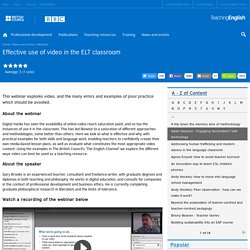
This has led likewise to a saturation of different approaches and methodologies, some better than others. Here we look at what is effective and why, with practical examples for both skills and language work, enabling teachers to confidently create their own media-based lesson plans, as well as evaluate what constitutes the most appropriate video content. Video and young learners 1. Some ideas for the kinds of video suitable for young learners are also given.
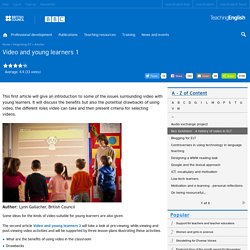
The second article Video and young learners 2 will take a look at pre-viewing, while-viewing and post-viewing video activities and will be supported by three lesson plans illustrating these activities. What are the benefits of using video in the classroomDrawbacksRole of videoCriteria for selecting videoVideo typesFurther reading and bibliography What are the benefits of using video in the classroom? Learners aged 3 - 8 Children enjoy language learning with video'One of the aims of teaching English to young children is to instil in them the idea that language learning is a happy experience, and video creates an attractive enjoyable learning environment.' All Young Learners. A beginner's guide to mobile learning in ELT.
In this practical seminar Amy Lightfoot explores the current opportunities for learning English using mobile phones both in and out of the classroom.
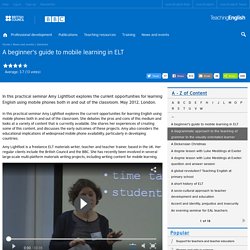
She debates the pros and cons of this medium and looks at a variety of content that is currently available. She shares her experiences of creating some of this content, and discusses the early outcomes of these projects. Amy also considers the educational implications of widespread mobile phone availability, particularly in developing countries. Amy Lightfoot is a freelance ELT materials writer, teacher and teacher trainer, based in the UK.
Her regular clients include the British Council and the BBC. Realia. Here are a few suggestions for activities using realia and to consider why we may want to bring things into the class.

Why use realia in class? The main advantage of using real objects in the classroom is to make the learning experience more memorable for the learner. To give a couple of simple examples, if you are going to teach vocabulary of fruit and vegetables it can be much more affective for students if they can touch, smell and see the objects at the same time as hearing the new word. This would appeal to a wider range of learner styles than a simple flashcard picture of the fruit or vegetable. A second example would be if you are going to teach some functional language for asking for the timetable for a train. Here is a selection of activities involving realia. Tourist information Gather some city/town maps from the tourist information bureau wherever you are. ConcentrationSee these instructions on how to play this game:www.teachingenglish.org.uk/article/concentration Further reading.
The image in English Language Teaching. Each of these leading experts provide insightful articles and practical ideas for using still and moving images in language education. The list of contributors include Ben Goldstein, Anna Whitcher, Antonia Clare, Paul Driver, Sylvia Karasthati, Paul Dummett, Magdalena Wasilewska, Andreia Zakime, Elena Domínguez Romero, Jelena Bobkina, Candy Fresacher, Tyson Seburn, Chrysa Papalazarou, Magdalena Brzezinska, Emma Louise Pratt, Samantha Lewis, Jean Theuma, and Valéria Benévolo França who are all also members of the Visual Arts Circle, a collective which provides a wide range of resources for you to use and encourages discussion and debate around the use of images in language teaching. The book includes a preface by Gunther Kress, Professor of Semiotics and Education in the Department of Culture, Communication and Media Within the Institute of Education of University College London.
Materials and methodology: How to create resources from nothing. Crazy animals and other activities for teaching young learners. It brings together the experience and expertise of teachers from around the world to provide a range of stimulating and exciting classroom activities for the primary classroom.
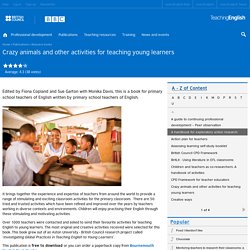
Dogme. Skip to content Dogme is an approach to teaching that argues that teaching should focus on the learner and not be driven by the resources available, including course books.
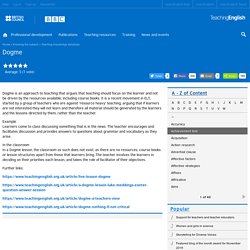
It is a recent movement in ELT, started by a group of teachers who are against 'resource heavy' teaching, arguing that if learners are not interested they will not learn and therefore all material should be generated by the learners and the lessons directed by them, rather than the teacher. ExampleLearners come to class discussing something that is in the news. Teaching without a coursebook. What's wrong with using a coursebook?
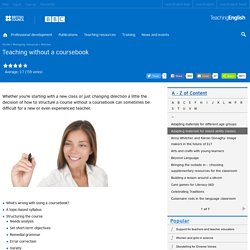
A topic-based syllabusStructuring the courseNeeds analysisSet short-term objectivesRemedial grammarError correctionVarietyConclusion What's wrong with using a coursebook? Well, in many cases, nothing! With the constant updating of text books to include new and relevant topics, ideas and methodology, teachers have a great set of resources at their fingertips. Students however may not see it that way. TEGL4: Teaching websites and apps (Responses) : the collaborative whiteboard platform for distributed teams. ClassroomScreen. 10 things I do with my Mini-WhiteBoards – chiasuanchong. It all started when a co-tutor on the CELTA suggested that I borrow some mini-white boards for an input session on boardwork.
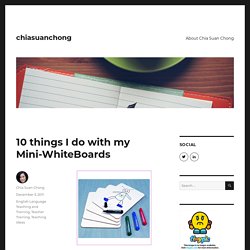
My trainees had so much fun drawing pictures of varying degrees of artistic proficiency to convey meaning of the words ‘prawn’, ‘chess’ and ‘aubergine’ while I was also able to provide a much more hands-on practice session of organizing collocations, using mindmaps, and marking phonological features. I decided then to invest in my own set of mini-whiteboards and they have been a hit in the staffroom since. I now use it for both teacher training, English teaching and even exam preparation classes. MR How do you use board Tips for using your board effectively. MR safer internet day resources.
What's your name? Introduction: For a listening lesson to be successful, the learners need to be engaged with the audio.

It might not always be possible to motivate all the learners in the class to the same degree but the important thing is to use an audio which all of the learners can, in some way, relate to. If you are in a position where you can choose an audio, ask yourself ‘Will each and every one of the learners recognise this? Will they be able to say something about it? Will they have an opinion about it?’ This month’s lesson mainly focuses on developing listening skills but other skills are integrated too, with opportunities for speaking, reading and writing. Topic: Names - an integrated skills lesson with the main focus on listening Aims: To develop students’ listening skills To engage students in a classroom discussion To encourage students to think about the cultural significance of names Age: Teenagers and young adults Level: A2-B2 Time: 60 minutes + Materials:
TE LP Nov 14. Space - the sun, moon, stars and planets. Skype in the Classroom (Preview) Helping students control their mobile devices. Published 16 November 2018 Nik Peachey is a freelance teacher trainer, writer, course designer, conference speaker and learning technology consultant.
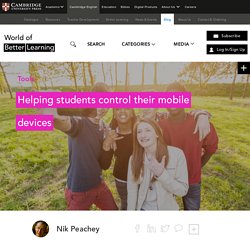
He is a two-time British Council Innovations Award Winner and is a keen blogger and content curator. General English - Magazine. April Fool's Day is celebrated on 1 April in many countries around the world. On this day, people traditionally play practical jokes on each other and have fun trying to make other people believe things that are not true. April Fool's traditions In the UK, jokes and tricks can be played up until noon on 1 April. After midday it's considered bad luck to play a trick. Teaching kids space the sun moon stars and planets lesson plan. Writing practice problem page answers.
Writing practice problem page worksheet. Flashcard maker. Feed the Dog Sight Word Activity. MR Flashcard techniques. Process writing. This site uses cookies to help make it more useful to you. Find out more about cookies. Video lessons. In this video we will be showing you why we like How It Should Have Ended For Kids. We're focusing on two playlists: Silly Songs and Fixed Fairy Tales, with some practical ideas about how we use them in teaching young learners. Here's a link to an interactive video quiz at our site for one of the videos from the channel, and here's a link to the channel itself. English ESL worksheets for home learning and physical classrooms. 25 Ways to Use Sticky Notes in the Classroom.
Sticky notes got their start nearly 40 years ago, when 3M introduced the now-classic yellow Post-it Notes. In the years since, their popularity has skyrocketed, and they’re now available in every shape, size, and color you can imagine. They have endless applications, especially in schools; teachers use sticky notes for math, reading, art, planning, and so much more. Here are 25 clever ways to use sticky notes in the classroom. Using cartoons and comic strips. Cartoons are powerful teaching tools and can: Primary Resources - KS2, KS1, Early Years (EYFS) KS3, KS4, Twinkl.